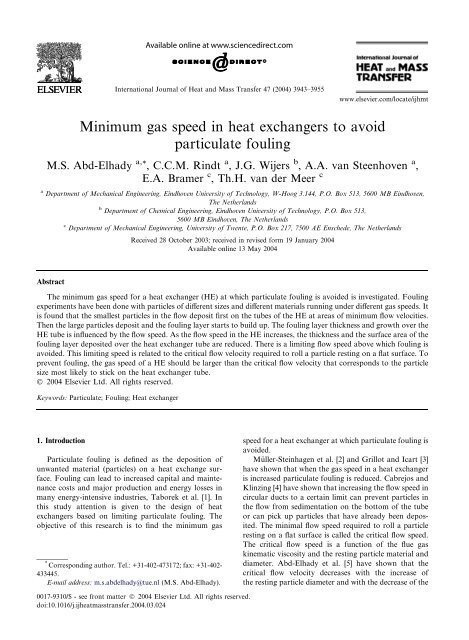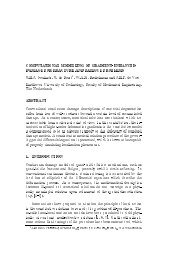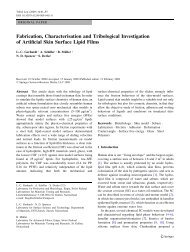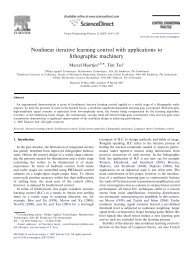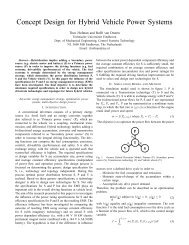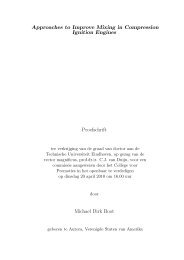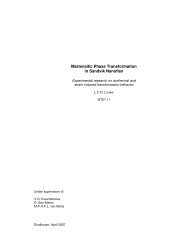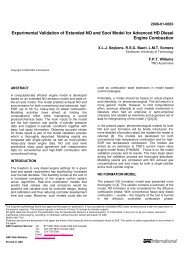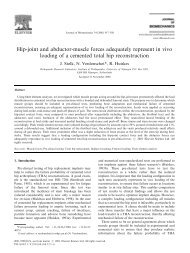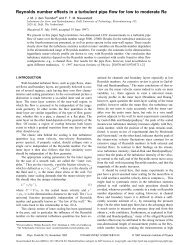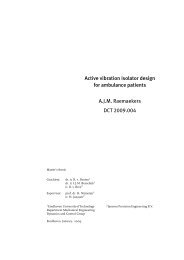Minimum gas speed in heat exchangers to avoid particulate fouling
Minimum gas speed in heat exchangers to avoid particulate fouling
Minimum gas speed in heat exchangers to avoid particulate fouling
You also want an ePaper? Increase the reach of your titles
YUMPU automatically turns print PDFs into web optimized ePapers that Google loves.
3946 M.S. Abd-Elhady et al. / International Journal of Heat and Mass Transfer 47 (2004) 3943–3955Fig. 2. Particle size distributions (PSD, left) and scann<strong>in</strong>g electron microscope (SEM, right) pho<strong>to</strong>s of glass (a,b), bronze (c,d) andcopper particles (e,f), respectively.The cool<strong>in</strong>g airflow rate is also controlled through acritical nozzle and a pressure regula<strong>to</strong>r.Foul<strong>in</strong>g of the <strong>heat</strong> exchanger tube is moni<strong>to</strong>redus<strong>in</strong>g a digital camera through a glass w<strong>in</strong>dow <strong>in</strong>stalled<strong>in</strong> the <strong>heat</strong> exchanger section as shown <strong>in</strong> Fig. 1b. Thedigital camera is the F<strong>in</strong>epix S602 zoom, with a resolutionof 2832 pixels · 2128 pixels, i.e. 6.03 million pixels.The digital camera has a 6· optical zoom which compared<strong>to</strong> small image format has a zoom area of 35–210mm. The foul<strong>in</strong>g layer thickness is measured optically.Images are taken of the <strong>heat</strong> exchanger tubes before anddur<strong>in</strong>g foul<strong>in</strong>g. The clean <strong>heat</strong> exchanger tube radius istaken as a reference. The tube radii <strong>in</strong> the camera imagesand hence the foul<strong>in</strong>g layer thicknesses are determ<strong>in</strong>edwith an accuracy of ±1 pixel which corresponds <strong>to</strong> ±0.04mm. The temperatures of the hot air and the cool<strong>in</strong>g airbefore and after the <strong>heat</strong> exchanger are measured us<strong>in</strong>gK type thermocouples with an accuracy of ±0.4 °C. Theair <strong>speed</strong> at the exit of the <strong>heat</strong> exchanger section ismeasured by a hot wire anemometer with an accuracy of±0.015 m/s. Air exhaust from the setup is filteredthrough a bag filter before it goes <strong>in</strong><strong>to</strong> the atmosphere.Each foul<strong>in</strong>g experiment is carried out <strong>in</strong> the follow<strong>in</strong>gprocedure: Hot and cold airflow rates are adjusted<strong>to</strong> the desired flow rates at the beg<strong>in</strong>n<strong>in</strong>g of theexperiment. The hot air temperature is adjusted throughthe air <strong>heat</strong>er and the experiment is kept runn<strong>in</strong>g till asteady state is reached. After a steady state has beenreached, particles are <strong>in</strong>jected at the desired rate and thefoul<strong>in</strong>g process is moni<strong>to</strong>red.3. Results and discussion3.1. Influence of flow <strong>speed</strong> on growth of foul<strong>in</strong>g layerThe follow<strong>in</strong>g experiments are performed <strong>to</strong> see the<strong>in</strong>fluence of flow <strong>speed</strong> on the growth of the foul<strong>in</strong>g layerand <strong>to</strong> determ<strong>in</strong>e the flow <strong>speed</strong> at which foul<strong>in</strong>g ceases.Two types of particles are used <strong>in</strong> the experiments, thenon-metallic glass particles and the metallic bronze andcopper particles def<strong>in</strong>ed <strong>in</strong> the previous section.In the first experiments, glass particles have been<strong>in</strong>jected <strong>in</strong> the flow at different <strong>gas</strong> flow <strong>speed</strong>s and thefoul<strong>in</strong>g behavior is moni<strong>to</strong>red. The average airflow<strong>speed</strong> between the tubes has been changed from 2.7 <strong>to</strong>3.8 <strong>to</strong> 5 m/s and <strong>in</strong> each case the operat<strong>in</strong>g time was 9 h.The air temperature is 200 °C and the particles
M.S. Abd-Elhady et al. / International Journal of Heat and Mass Transfer 47 (2004) 3943–3955 3947Fig. 3. Foul<strong>in</strong>g layer at the end of 9 h of operation for different flow <strong>speed</strong>s. The foulant is spherical glass particles of diameter 21 ± 16lm. (a) V ¼ 2:7 m/s; (b) V ¼ 3:8 m/s; (c) V ¼ 5 m/s.Table 1Comparison between the foul<strong>in</strong>g behaviors for glass particles under different operat<strong>in</strong>g conditionsAverage airflow <strong>speed</strong> between the HE V ¼ 2:7 m/s V ¼ 3:8 m/s V ¼ 5 m/stubesF<strong>in</strong>al thickness (mm) 1 0.75 0.3Circumferential and radial growth Cont<strong>in</strong>ues Starts very fast and thendecreases abruptlyStarts very fast and thendecreases abruptlyconcentration is 0.15 g/N m 3 of flow<strong>in</strong>g air. Fig. 3 showsthe foul<strong>in</strong>g layer at the end of operation for the abovementionedcases. Table 1 shows a comparison betweenthe three different cases. It is shown that as the <strong>speed</strong> ofthe flow <strong>in</strong>creases, the foul<strong>in</strong>g layer surface area andthickness are reduced. Increas<strong>in</strong>g the average air <strong>speed</strong>between the <strong>heat</strong> exchanger (HE) tubes from 2.7 <strong>to</strong> 5 m/sreduces the f<strong>in</strong>al foul<strong>in</strong>g layer thickness from 1 <strong>to</strong> 0.3mm after 9 h of operation. When the average flow <strong>speed</strong>between the HE tubes is 2.7 m/s, it is found that thecircumferential and radial growth of the foul<strong>in</strong>g layercont<strong>in</strong>ued from the beg<strong>in</strong>n<strong>in</strong>g till the end of the experiment.Increas<strong>in</strong>g the average flow <strong>speed</strong> between the HEtubes <strong>to</strong> 3.8 and 5 m/s showed a different foul<strong>in</strong>gbehavior. The foul<strong>in</strong>g rate was very high at the beg<strong>in</strong>n<strong>in</strong>g,especially for the first 3 h. Then the foul<strong>in</strong>g ratestarted <strong>to</strong> decrease abruptly for the next 6 h of operation,till hardly any radial or circumferential growth canbe seen.Figs. 4 and 5 show the growth of the foul<strong>in</strong>g layer forglass particles over the <strong>heat</strong> exchanger tube as a functionof time. The average air <strong>speed</strong> between the tubes is 2.7m/s for Fig. 4 and 3.8 m/s for Fig. 5. Fig. 4a shows thatat the beg<strong>in</strong>n<strong>in</strong>g of the foul<strong>in</strong>g process, some particlesstart <strong>to</strong> deposit at <strong>in</strong>termittent and distant positions.These po<strong>in</strong>ts of deposition start <strong>to</strong> grow radially, Fig.4b–e, till the whole surface of the <strong>heat</strong> exchanger tube iscovered completely with particles, Fig. 4f. The surficialgrowth of the foul<strong>in</strong>g layer is emphasized by the encircledareas <strong>in</strong> Figs. 4a–f. The surficial growth of thefoul<strong>in</strong>g layer can be expla<strong>in</strong>ed by the fact that f<strong>in</strong>eparticles are most likely <strong>to</strong> stick first <strong>to</strong> the HE tubesbecause of their higher stick<strong>in</strong>g velocity compared <strong>to</strong>coarse particles [7]. Then larger particles, which deposi<strong>to</strong>n the <strong>heat</strong> exchanger tube and stand alone <strong>in</strong> theshear<strong>in</strong>g flow, start <strong>to</strong> roll over the <strong>heat</strong> exchanger tubeif the shear<strong>in</strong>g flow <strong>speed</strong> is above a certa<strong>in</strong> limit. Theparticle roll<strong>in</strong>g motion is s<strong>to</strong>pped when it is blocked by astand<strong>in</strong>g heap of particles, which leads <strong>to</strong> the surficialgrowth of the fouled areas till they cover the unfouledsurfaces. The flow <strong>speed</strong> required <strong>to</strong> roll a particlerest<strong>in</strong>g on a flat surface, and, the stick<strong>in</strong>g velocity of aparticle, will respectively be discussed <strong>in</strong> detail <strong>in</strong> thefollow<strong>in</strong>g subsequent sections.Fig. 5 shows that at the beg<strong>in</strong>n<strong>in</strong>g of the foul<strong>in</strong>gexperiment, Fig. 5b, the glass particles <strong>in</strong> the flow started<strong>to</strong> deposit on the rear end of the HE tube and cont<strong>in</strong>ued<strong>to</strong> the circumference, Fig. 5c–e. The rear end of the <strong>heat</strong>exchanger, Fig. 5f, is subjected <strong>to</strong> the lowest shear<strong>in</strong>gforces due <strong>to</strong> separation of flow from the tube surface,Achenbach [9]. The flow field for the exam<strong>in</strong>ed HEshown <strong>in</strong> Fig. 1 is solved us<strong>in</strong>g the f<strong>in</strong>ite volume methodapplied by the commercial CFD-package CFX version4.2. The low Reynolds number k–e model is used <strong>to</strong> solvethe flow field around the HE tubes. For all but theadvection terms, use is made of a second-order centraldifferenc<strong>in</strong>g scheme. In the equations for the velocitycomponents, use is made of the third order QUICK<strong>in</strong>terpolation scheme for the advection terms. For the kand e equations the first order HYDRID-scheme is appliedwhich is more stable than the QUICK scheme andensures the k and e values <strong>to</strong> rema<strong>in</strong> positive <strong>in</strong> theconverged solution. In the computations use is made ofthe SIMPLEC pressure-correction scheme <strong>in</strong> which thepressure field is <strong>in</strong>directly specified via the cont<strong>in</strong>uityequation. For the u and the v velocity use is made of theS<strong>to</strong>ne’s method, for the turbulence quantities a l<strong>in</strong>erelaxationmethod is used and an algebraic multi-gridmethod is applied for the pressure equation. The flowfield is solved for a turbulent flow, at Re ¼ 2 10 5 , which
3948 M.S. Abd-Elhady et al. / International Journal of Heat and Mass Transfer 47 (2004) 3943–3955Fig. 4. Progress of the foul<strong>in</strong>g layer over the HE tube with<strong>in</strong> 9 h of operation. The foulant is spherical glass particles of diameter21 ± 16 lm. The average air <strong>speed</strong> between the HE tubes is 2.7 m/s: (a) after 1 h of operation, (b) after 1.5 h of operation, (c) after 2 h ofoperation, (d) after 2.5 h of operation, (e) after 3 h of operation, (f) after 9 h of operation.Fig. 5. Growth of the foul<strong>in</strong>g layer over the HE tube with<strong>in</strong> 6 h of operation. The foulant is spherical glass particles of diameter 21 ± 16lm. The average air <strong>speed</strong> between the tubes is 3.8 m/s: (a) at the beg<strong>in</strong>n<strong>in</strong>g, (b) after 0.5 h of operation, (c) after 1 h of operation, (d)after 1.5 h of operation, (e) after 2 h of operation, (f) after 6 h of operation.corresponds <strong>to</strong> a superficial flow velocity of 10 m/s. Fig. 7shows the velocity con<strong>to</strong>urs <strong>in</strong> the y and x directions forthe HE shown <strong>in</strong> Fig. 1. Although the CFD calculationsshow that the flow around the middle centered tube is notperiodic, this centered tube can be regarded as a representativefor a tube <strong>in</strong> a tube bundle. It is shown that for
M.S. Abd-Elhady et al. / International Journal of Heat and Mass Transfer 47 (2004) 3943–3955 3949Fig. 6. A summary for the foul<strong>in</strong>g layer circumferential growth shown <strong>in</strong> Fig. 5.the middle centered tube the flow keeps attached <strong>to</strong> thetube surface and then separates at an angle of 120° fromthe stagnation po<strong>in</strong>t. From the numerical results it couldalso be concluded that there is more air circulation at thefront than <strong>in</strong> the rear end of the middle centered HEtube, Fig. 7c and d. Therefore particles that stick <strong>to</strong> therear end of the HE tube are more likely <strong>to</strong> rema<strong>in</strong> <strong>in</strong>position than particles that stick <strong>to</strong> the sides of the HEtube. A particle that sticks <strong>to</strong> the side of the HE tube rollsover the HE tube if the airflow <strong>speed</strong> is above a certa<strong>in</strong>limit, and s<strong>to</strong>ps if it is blocked by the rest<strong>in</strong>g particles atthe rear end of the <strong>heat</strong> exchanger tube. Therefore foul<strong>in</strong>gstarts at areas that are subjected <strong>to</strong> m<strong>in</strong>imum shear<strong>in</strong>gforces and then spreads due <strong>to</strong> particle transport <strong>to</strong>the already deposited particles. Fig. 6 summarizes thecircumferential growth of the foul<strong>in</strong>g layer shown <strong>in</strong> Fig.5.3.2. Limit<strong>in</strong>g foul<strong>in</strong>g <strong>speed</strong>The previous set of experiments has shown that asthe flow <strong>speed</strong> <strong>in</strong> the HE <strong>in</strong>creases, the thickness and thesurface area of the foul<strong>in</strong>g layer deposited over the HEtube are reduced. The follow<strong>in</strong>g experiments are done <strong>to</strong>determ<strong>in</strong>e the flow <strong>speed</strong> at which foul<strong>in</strong>g of the <strong>heat</strong>exchanger is prevented. The results of the experimentwill be compared <strong>to</strong> the results achieved with an analyticalmodel. The analytical model is only valid forspherical non-charged particles. The analytical model isbased on the m<strong>in</strong>imum shear velocity required <strong>to</strong> roll aparticle on a flat surface. It can be applied for a cyl<strong>in</strong>dricaltube if the particle diameter is much smaller thanthe cyl<strong>in</strong>der diameter, as is the case here. The shear flow<strong>speed</strong> required <strong>to</strong> roll a particle deposited on a flatsurface is called the critical flow velocity and it is afunction of the particle material and size and the surfacematerial. The critical flow velocity can be calculatedwhen assum<strong>in</strong>g that the hydrodynamic roll<strong>in</strong>g momentdue <strong>to</strong> the drag force, F d , lift force, F L , and buoyancyforce, F b , is greater than the rest<strong>in</strong>g adhesion momentdue <strong>to</strong> the surface adhesion force, F a , and the force ofgravity, F g . The ratio between the hydrodynamic roll<strong>in</strong>gmoment and the adhesion rest<strong>in</strong>g moment is def<strong>in</strong>ed byZhang et al. [10] as RM and equal <strong>to</strong>RM ¼¼Hydrodynamic roll<strong>in</strong>g momentAdhesion rest<strong>in</strong>g momentF d ð1:399R aÞðF a þ F g F b F L Þd=2 ; ð1Þwhere R, d and a are the particle radius, contact diameterand the particle radius of deformation, respectively.If the RM value is greater than 1, roll<strong>in</strong>g will takeplace. Abd-Elhady et al. [5] have calculated the criticalflow velocity for spherical copper particles of diametersrang<strong>in</strong>g from 5 <strong>to</strong> 50 lm, the results are shown <strong>in</strong> Fig. 8.The ma<strong>in</strong> flow stream velocity, i.e. the critical flowvelocity, required <strong>to</strong> roll a copper particle of 10 lm is10.5 m/s while for a 50 lm copper particle this velocity is4.5 m/s.Due <strong>to</strong> the comparison with the analytical modelpresented above, <strong>in</strong> the experiments only sphericalmetallic particles are used. The HE is operated at differentair flow<strong>in</strong>g <strong>speed</strong>s and different particle sizes <strong>to</strong>determ<strong>in</strong>e the operat<strong>in</strong>g <strong>speed</strong> at which foul<strong>in</strong>g is preventedas function of the particles size <strong>in</strong> the flow. Theflow <strong>speed</strong> at which foul<strong>in</strong>g is prevented, is <strong>in</strong>vestigatedfor copper particles of average diameter 10 lm with astandard deviation of 5 lm suspended <strong>in</strong> the airflow andalso for bronze particles of average diameter 55 lm witha standard deviation of 6 lm. The air temperature is 20°C and the particle concentration is 2 g/m 3 of airflow.The <strong>heat</strong> exchanger is kept runn<strong>in</strong>g for 8 h <strong>in</strong> eachexperiment. Experimental results of the foul<strong>in</strong>g experimentare plotted <strong>in</strong> Fig. 8. Fig. 8 shows that when air iscontam<strong>in</strong>ated with the copper particles of averagediameter 10 lm the HE tubes fouled when the averageflow <strong>speed</strong> between the tubes was lower than 9.5 m/s, i.e.
3950 M.S. Abd-Elhady et al. / International Journal of Heat and Mass Transfer 47 (2004) 3943–3955Fig. 7. Velocity con<strong>to</strong>urs <strong>in</strong> the y (left) and x (right) directions for the HE section (a,b) shown <strong>in</strong> Fig. 1b and for the middle centeredtube (c,d), respectively. Reynolds number is 2 · 10 5 .7.5 and 2.7 m/s. It is also shown that when the air iscontam<strong>in</strong>ated with the bronze particles of averagediameter 55 lm the HE tubes fouled when the averageflow <strong>speed</strong> between the tubes was lower than 5.5 m/s, i.e.4.5 and 2 m/s. Fig. 9 shows images for the HE tube at theend of the foul<strong>in</strong>g experiments <strong>in</strong> case the airflow iscontam<strong>in</strong>ated with bronze particles of average diameter55 lm. Fig. 9 shows that when the flow <strong>speed</strong> betweenthe tubes is equal <strong>to</strong> 2 m/s the foul<strong>in</strong>g layer thicknessbecomes 0.3 mm and dim<strong>in</strong>ishes when the flow <strong>speed</strong>becomes 5.5 m/s. The m<strong>in</strong>imum flow <strong>speed</strong> at whichfoul<strong>in</strong>g <strong>in</strong> a <strong>heat</strong> exchanger is prevented will be called thelimit<strong>in</strong>g foul<strong>in</strong>g <strong>speed</strong>.The copper particles used <strong>in</strong> the experiments have awide particle size distribution rang<strong>in</strong>g from 1 <strong>to</strong> 20 lm,as shown <strong>in</strong> Fig. 2e. Surpris<strong>in</strong>gly, no foul<strong>in</strong>g was found
M.S. Abd-Elhady et al. / International Journal of Heat and Mass Transfer 47 (2004) 3943–3955 3951Air flow velocity (m/s) .1614121086420Copper particles0 10 20 30 40 50 60Particle's diameter (µm).of the copper particles smaller than 10 lm at a flowvelocity of 9.5 m/s. This could be due <strong>to</strong> the smallamount of the f<strong>in</strong>e particles present and due <strong>to</strong> the removalof them by larger hitt<strong>in</strong>g particles. The removal off<strong>in</strong>e particles by the large deposit<strong>in</strong>g particles leads <strong>to</strong> alower limit<strong>in</strong>g foul<strong>in</strong>g <strong>speed</strong> than the limit<strong>in</strong>g foul<strong>in</strong>g<strong>speed</strong>, which corresponds <strong>to</strong> the smallest particle <strong>in</strong> the<strong>gas</strong> flow. The effect of the particle size distribution onthe foul<strong>in</strong>g mechanism still has <strong>to</strong> be <strong>in</strong>vestigated.The critical flow velocity shown <strong>in</strong> Fig. 8 is calculatedfor a metallic non-charged spherical copper particlerest<strong>in</strong>g on a good conduc<strong>to</strong>r surface. In case of anelectrically charged particle rest<strong>in</strong>g on a bad conduc<strong>to</strong>rsurface like glass an electrostatic adhesion force isdeveloped which leads <strong>to</strong> a higher critical flow velocitythan <strong>in</strong> case of a non-charged particle. The critical flowvelocity then should be calculated based on the nature ofthe particles <strong>in</strong> the flow and the flow conditions.3.3. Stick<strong>in</strong>g of particlesCritical flow velocity (Theoretical).No Foul<strong>in</strong>g Condition (Experimental).Foul<strong>in</strong>g Condition (Experimental).Bronze particlesFig. 8. The critical flow velocity and limit<strong>in</strong>g foul<strong>in</strong>g <strong>speed</strong>versus particle diameter.In practical applications of <strong>heat</strong> <strong>exchangers</strong> especially<strong>in</strong> waste <strong>in</strong>c<strong>in</strong>era<strong>to</strong>rs, the flue <strong>gas</strong>es conta<strong>in</strong> a wide rangeof particle sizes. To prevent foul<strong>in</strong>g of <strong>heat</strong> <strong>exchangers</strong>based on the critical flow velocity, the critical flowvelocity should be selected based on the particle sizemost likely <strong>to</strong> stick first <strong>to</strong> the <strong>heat</strong> exchanger tubes. Thefollow<strong>in</strong>g experiments have been done <strong>to</strong> determ<strong>in</strong>ewhich particle size deposits first from a batch of particlesflow<strong>in</strong>g over a <strong>heat</strong> exchanger tube. A mixture of equalmasses of bronze and copper particles is <strong>in</strong>jected <strong>in</strong><strong>to</strong> theairflow. The bronze and copper particles used are def<strong>in</strong>ed<strong>in</strong> the experimental setup section. The particlesconcentration is 2 g/m 3 of airflow. Hot air at 200 °C andflow rate of 13E)3 Nm 3 /s is passed <strong>to</strong> the <strong>heat</strong> <strong>exchangers</strong>ection. This results <strong>in</strong> a Reynolds number of700 based on the HE tube diameter and the superficialflow velocity. An airflow rate of 1.5E)3 Nm 3 /s and atemperature of 20 °C was used for cool<strong>in</strong>g the <strong>heat</strong> exchangertube <strong>in</strong>ternally. The <strong>heat</strong> exchanger has run for9 h. At the end of the foul<strong>in</strong>g experiment samples aretaken from the foul<strong>in</strong>g layer deposited on the <strong>heat</strong> exchangertube and these are exam<strong>in</strong>ed by SEM. Twosamples of particles are taken from the foul<strong>in</strong>g layerdeposited on the middle centered tube of the <strong>heat</strong> <strong>exchangers</strong>ection: The first sample of particles was scratchedfrom the <strong>to</strong>p of the foul<strong>in</strong>g layer. The secondsample of particles was scratched from the first foul<strong>in</strong>glayer of particles, which had deposited on the tube of the<strong>heat</strong> exchanger. This sample was taken by blow<strong>in</strong>g airthrough the HE at a very high <strong>speed</strong> such that most ofthe foul<strong>in</strong>g layer was blown off and only a very th<strong>in</strong> layerof particles rema<strong>in</strong>ed on the tube of the <strong>heat</strong> exchanger.Fig. 10 shows SEM pictures for the particles at thebot<strong>to</strong>m (near the <strong>heat</strong> exchanger tube) and at the <strong>to</strong>p ofthe foul<strong>in</strong>g layer respectively. First the f<strong>in</strong>e copper particleshave accumulated over the <strong>heat</strong> exchanger tubeand then afterwards the larger bronze particles. The <strong>to</strong>pof the foul<strong>in</strong>g layer consisted ma<strong>in</strong>ly of the large bronzeparticles surrounded by the f<strong>in</strong>e copper particles.The same k<strong>in</strong>d of experiment above is repeated us<strong>in</strong>gspherical glass particles <strong>in</strong>stead of us<strong>in</strong>g a mixture ofFig. 9. Pho<strong>to</strong>s for the exam<strong>in</strong>ed <strong>heat</strong> exchanger tube at the end of operation under different airflow velocities: (a) V ¼ 2 m/s, a bronzelayer of thickness 0.3 mm is formed on the HE steel tube; (b) V ¼ 4:5 m/s, a very f<strong>in</strong>e layer of bronze particles is formed; (c) V ¼ 5:5 m/s, no foul<strong>in</strong>g.
3952 M.S. Abd-Elhady et al. / International Journal of Heat and Mass Transfer 47 (2004) 3943–3955Fig. 10. Scann<strong>in</strong>g electron microscope pho<strong>to</strong>s for the particles at the bot<strong>to</strong>m (left) and <strong>to</strong>p (right) of the foul<strong>in</strong>g layer. The foul<strong>in</strong>g layeris composed of a mixture of copper and bronze particles.Fig. 11. Scann<strong>in</strong>g electron microscope pho<strong>to</strong>s for the particles at the bot<strong>to</strong>m (left) and <strong>to</strong>p (right) of the foul<strong>in</strong>g layer. The particles aremade of glass.bronze and copper particles. Fig. 11 shows SEM pho<strong>to</strong>sfor the particles at the bot<strong>to</strong>m (near the <strong>heat</strong> exchangertube) and <strong>to</strong>p of the foul<strong>in</strong>g layer. At the <strong>to</strong>p of thefoul<strong>in</strong>g layer large particles have accumulated with smallparticles <strong>in</strong> between. In the foul<strong>in</strong>g layer near the tube ofthe <strong>heat</strong> exchanger, the f<strong>in</strong>est particles <strong>in</strong> the flow haveagglomerated <strong>to</strong>gether <strong>to</strong> form islands of f<strong>in</strong>e particlesconnected <strong>to</strong> bigger particles. Fig. 12 and Table 2 show acomparison between the particles size distribution of the<strong>in</strong>jected glass particles <strong>in</strong> the airflow and the glass particles<strong>in</strong> the foul<strong>in</strong>g layer near the HE tube. It is shownthat the average diameter of the glass particles has reducedfrom 20.4 lm <strong>in</strong> the airflow <strong>to</strong> 14.7 lm <strong>in</strong>thefoul<strong>in</strong>g layer near the HE tube. 90% of the <strong>in</strong>jected glassparticles <strong>in</strong> the airflow have a diameter less than 43.1 lmwhile 90% of the glass particles <strong>in</strong> the foul<strong>in</strong>g layer nearthe HE tube have a diameter less than 25.2 lm. Thereduction <strong>in</strong> particle size <strong>in</strong> the foul<strong>in</strong>g layer near the HEtube from the particle size <strong>in</strong> the airflow is due <strong>to</strong> thehigher stick<strong>in</strong>g velocity of small particles compared <strong>to</strong>large particles as def<strong>in</strong>ed by Rogers and Reed [7].Rogers and Reed [7] developed a model that describesthe adhesion of a particle <strong>to</strong> a surface follow<strong>in</strong>g anelastic–plastic impact. The model is based upon considerationof the energy balance dur<strong>in</strong>g a normal impactbetween a sphere and a massive plane. The model describesthe adhesion of a particle aris<strong>in</strong>g from only elasticdeformations occurr<strong>in</strong>g dur<strong>in</strong>g the approach of the particle<strong>to</strong> the surface. When the particle velocity is reduced<strong>to</strong> zero dur<strong>in</strong>g the approach phase, part of the particle<strong>in</strong>itial k<strong>in</strong>etic energy, Q k , is converted <strong>in</strong><strong>to</strong> s<strong>to</strong>red elasticenergy, Q E , while the rema<strong>in</strong>der, Q L , is dissipated. This isthen followed by the recovery of the s<strong>to</strong>red elastic energy,which is converted <strong>in</strong><strong>to</strong> k<strong>in</strong>etic energy of the rebound<strong>in</strong>gparticle. For a particle of mass m impact<strong>in</strong>g a surfacenormally with a velocity V im we have1mV 22 im þ Q A ¼ Q E þ Q L ;ð2Þwhere Q A is the energy due <strong>to</strong> the attractive forces betweenthe <strong>in</strong>com<strong>in</strong>g particle and the surface. If the s<strong>to</strong>redelastic energy, Q E , is greater than the adhesive energyrequired <strong>to</strong> separate the particle from the surface, Q 0 A ,then the particle will rebound otherwise it sticks <strong>to</strong> thesurface. The rebound <strong>speed</strong>, V r , is calculated from1mV 22 r¼ Q E Q 0 A : ð3ÞThe mentioned energy terms are described <strong>in</strong> detail byRogers and Reed and <strong>in</strong> van Beek [11]. The maximum
M.S. Abd-Elhady et al. / International Journal of Heat and Mass Transfer 47 (2004) 3943–3955 3953Fig. 12. A comparison between the particle size distribution of the <strong>in</strong>jected glass particles <strong>in</strong> the airflow and the glass particles <strong>in</strong> thefirst foul<strong>in</strong>g layers deposited on the HE tube.Table 2A comparison between the particle size distribution of the <strong>in</strong>jected glass particles <strong>in</strong> the airflow and the glass particles <strong>in</strong> the first foul<strong>in</strong>glayers deposited on the HE tubea b cMean diameter (d M ) Standard deviation (SD) D 10 D 50 D 90Injected glass particles<strong>in</strong> airflowGlass particle <strong>in</strong> thefoul<strong>in</strong>g layer nearthe HE tube20.4 16.2 3.6 16.2 43.114.7 8.4 5.9 13.3 25.2All dimensions are <strong>in</strong> micrometers.a The particle diameter at which 10% of the particles are smaller than it.b The particle diameter at which 50% of the particles are smaller than it.c The particle diameter at which 90% of the particles are smaller than it.impact <strong>speed</strong> at which an <strong>in</strong>cident particle will stick <strong>to</strong>the impacted surface, i.e. V r ¼ 0, is def<strong>in</strong>ed as the criticalstick<strong>in</strong>g velocity. To show the variation of the stick<strong>in</strong>gvelocity with the <strong>in</strong>cident particle diameter the Rogersand Reed model is solved <strong>to</strong> calculate the stick<strong>in</strong>gvelocity for copper particles of diameters 10 and 4 lmhitt<strong>in</strong>g a solid steel surface. Fig. 13 shows the variationof the coefficient of restitution, e, with the impact <strong>speed</strong>,V im , for copper particles of diameters 10 and 4 lm. Thecoefficient of restitution is def<strong>in</strong>ed as the ratio betweenthe normal rebound <strong>speed</strong>, V r , and the normal impact<strong>speed</strong>, V im , for a particle hitt<strong>in</strong>g a solid surface. Fig. 13shows that if a copper particle of diameter 10 lm hits asteel surface at a <strong>speed</strong> lower than 0.025 m/s it will stick,while a copper particle of diameter 4 lm sticks if it hitsat a velocity lower than 0.12 m/s. Therefore, if we have amixture of particles of diameters 10 and 4 lm <strong>in</strong> air,which is flow<strong>in</strong>g with an average <strong>speed</strong> of 1 m/s over aHE tube, there will be a larger number of particles thathit the HE tube with a <strong>speed</strong> lower than 0.12 m/s thanthe number of particles that hits with a <strong>speed</strong> lower than0.025 m/s. This can expla<strong>in</strong> why small particles are likely<strong>to</strong> dom<strong>in</strong>ate at the beg<strong>in</strong>n<strong>in</strong>g of the foul<strong>in</strong>g process.3.4. S<strong>in</strong>ter<strong>in</strong>g of foul<strong>in</strong>g layersOnce foul<strong>in</strong>g has started and particles accumulate <strong>to</strong>build up the foul<strong>in</strong>g layer, s<strong>in</strong>ter<strong>in</strong>g takes place. S<strong>in</strong>ter<strong>in</strong>gchanges the foul<strong>in</strong>g layer structure from a weakpowdery layer <strong>to</strong> a solid stable structure strongly attached<strong>to</strong> the <strong>heat</strong> exchanger tubes [12]. S<strong>in</strong>ter<strong>in</strong>g is afunction of time and of the hot <strong>gas</strong> temperature flow<strong>in</strong>gover the foul<strong>in</strong>g layer [13]. Fig. 14 shows a cross sectionalview for a foul<strong>in</strong>g layer taken from the previousexperiments mentioned above. The particles <strong>in</strong> the layerare bronze and were subjected <strong>to</strong> hot air at 200 °C for
3954 M.S. Abd-Elhady et al. / International Journal of Heat and Mass Transfer 47 (2004) 3943–3955Coefficient of restitution, e = V r / V im.10.90.80.70.60.50.40.30.20.10Stick<strong>in</strong>g limit =0.025 m/sStick<strong>in</strong>g limit = 0.12 m/sdp=10 micrometersdp=4 micrometers0 0.1 0.2 0.3 0.4 0.5 0.6 0.7 0.8 0.9 1 1.1 1.2 1.3 1.4 1.5Impact <strong>speed</strong> V im (m/s).Fig. 13. Coefficient of restitution versus impact <strong>speed</strong> for copper particles hitt<strong>in</strong>g a solid steel surface.Fig. 14. A cross sectional image through the foul<strong>in</strong>g layer, thearrows show the position of the scratches.9 h dur<strong>in</strong>g the foul<strong>in</strong>g experiments. Fig. 2d shows a SEMpho<strong>to</strong> for the bronze particles before usage <strong>in</strong> the foul<strong>in</strong>gexperiments. If we compare Figs. 2d and 14 we f<strong>in</strong>d thatmost of the bronze particles <strong>in</strong> the foul<strong>in</strong>g layer havescratches on the surface compared <strong>to</strong> the <strong>in</strong>itial particles.These scratches are probably the areas of contact whichhave been made up due <strong>to</strong> s<strong>in</strong>ter<strong>in</strong>g and were brokendur<strong>in</strong>g splitt<strong>in</strong>g of the foul<strong>in</strong>g layer for exam<strong>in</strong>ationunder the SEM. S<strong>in</strong>ter<strong>in</strong>g makes removal of the foul<strong>in</strong>glayer by soot blow<strong>in</strong>g afterwards difficult.An experimental setup has been built and developed<strong>to</strong> study the mechanism of foul<strong>in</strong>g over <strong>heat</strong> <strong>exchangers</strong>tubes as a function of flow <strong>speed</strong> and contam<strong>in</strong>at<strong>in</strong>gparticles. Foul<strong>in</strong>g starts at areas that are subjected <strong>to</strong>m<strong>in</strong>imum shear<strong>in</strong>g forces, the rear end of the tubes andthen spreads <strong>to</strong> the circumference due <strong>to</strong> particle transport<strong>to</strong> the already deposited particles. F<strong>in</strong>e particlesstick first <strong>to</strong> the <strong>heat</strong> exchanger tubes because of theirhigher stick<strong>in</strong>g velocity than coarse particles. Then thelarge particles deposit and the foul<strong>in</strong>g layer starts <strong>to</strong>build up. As the flow <strong>speed</strong> <strong>in</strong> the <strong>heat</strong> exchanger <strong>in</strong>creases,the thickness and the surface area of the foul<strong>in</strong>glayer deposited over the <strong>heat</strong> exchanger tube are reduced.The flow <strong>speed</strong> at which foul<strong>in</strong>g ceases is calledthe limit<strong>in</strong>g foul<strong>in</strong>g <strong>speed</strong>. The limit<strong>in</strong>g foul<strong>in</strong>g <strong>speed</strong> iscompared <strong>to</strong> the critical flow velocity required <strong>to</strong> roll aspherical particle rest<strong>in</strong>g on a flat surface and subjected<strong>to</strong> a shear flow. Depend<strong>in</strong>g on the particle size distribution<strong>in</strong> the <strong>gas</strong> flow, f<strong>in</strong>e particles deposited on the HEtube may be removed by the large deposit<strong>in</strong>g particles.The removal of f<strong>in</strong>e particles by the large deposit<strong>in</strong>gparticles leads <strong>to</strong> a lower limit<strong>in</strong>g foul<strong>in</strong>g <strong>speed</strong> than thelimit<strong>in</strong>g foul<strong>in</strong>g <strong>speed</strong>, which corresponds <strong>to</strong> the smallestparticle <strong>in</strong> the <strong>gas</strong> flow. The <strong>in</strong>fluence of the particle sizedistribution on the selection of the limit<strong>in</strong>g foul<strong>in</strong>g <strong>speed</strong>still has <strong>to</strong> be <strong>in</strong>vestigated <strong>in</strong> more detail. To preventfoul<strong>in</strong>g, the <strong>gas</strong> <strong>speed</strong> of a <strong>heat</strong> exchanger should belarger than the critical flow velocity that corresponds <strong>to</strong>the particle size most likely <strong>to</strong> stick first and rema<strong>in</strong> onthe HE tube. As the foul<strong>in</strong>g layer starts <strong>to</strong> build ups<strong>in</strong>ter<strong>in</strong>g takes place. S<strong>in</strong>ter<strong>in</strong>g gradually changes thelayer from a loose powdery structure <strong>to</strong> a more solidstructure strongly adhered <strong>to</strong> the <strong>heat</strong> exchanger tube.S<strong>in</strong>ter<strong>in</strong>g makes it difficult afterwards <strong>to</strong> clean the tubesby soot blow<strong>in</strong>g.4. Conclud<strong>in</strong>g discussionAcknowledgementsWe would like <strong>to</strong> acknowledge the staff members ofthe labora<strong>to</strong>ry of Thermal Eng<strong>in</strong>eer<strong>in</strong>g at the Universityof Twente for their assistance <strong>in</strong> prepar<strong>in</strong>g and perform<strong>in</strong>gthe experiments.
M.S. Abd-Elhady et al. / International Journal of Heat and Mass Transfer 47 (2004) 3943–3955 3955References[1] J. Taborek, T. Aoki, R.B. Ritter, J.W. Palen, J.G.Knudsen, Foul<strong>in</strong>g: the major unresolved problem <strong>in</strong><strong>heat</strong> transfer, Chem. Eng. Process 68 (2) (1972) 59–67.[2] H. M€uller-Ste<strong>in</strong>hagen, F. Reif, N. Epste<strong>in</strong>, P. Watk<strong>in</strong>son,Influence of operat<strong>in</strong>g conditions on <strong>particulate</strong> foul<strong>in</strong>g,Can. J. Chem. Eng. 66 (1988) 42–50.[3] J.M. Grillot, J. Icart, Foul<strong>in</strong>g of a cyl<strong>in</strong>drical probeand a f<strong>in</strong>ned tube bundle <strong>in</strong> a diesel exhaust environment,Exp. Thermal Fluid Sci. 14 (1997) 442–454.[4] F.J. Cabrejos, G.F. Kl<strong>in</strong>z<strong>in</strong>g, Incipient motion of solidparticles <strong>in</strong> horizontal pneumatic convey<strong>in</strong>g, PowderTechnol. 72 (1992) 51–61.[5] M.S. Abd-Elhady, C.C.M. R<strong>in</strong>dt, J.G. Wijers, A.A. vanSteenhoven, Removal of particles from powdery fouledsurfaces, <strong>in</strong>: J. Ta<strong>in</strong>e (Ed.), Proceed<strong>in</strong>gs of the TwelfthInternational Heat Transfer Conference, Grenoble,France, vol. 2, 2002, pp. 687–692.[6] M.C. van Beek, C.C.M. R<strong>in</strong>dt, J.G. Wijers, A.A. vanSteenhoven, Analysis of foul<strong>in</strong>g <strong>in</strong> refuse waste <strong>in</strong>c<strong>in</strong>era<strong>to</strong>rs,Heat Transfer Eng. 22 (2001) 22–31.[7] L.N. Rogers, J. Reed, The adhesion of particles undergo<strong>in</strong>gan elastic–plastic impact with a surface, J. Phys. D: Appl.Phys. 17 (1984) 677–689.[8] M. Fichman, D. Pneuli, Sufficient conditions for smallparticles <strong>to</strong> hold <strong>to</strong>gether because of adhesion forces,ASME J. Appl. Mech. 52 (1985) 105–108.[9] E. Achenbach, Distribution of local pressure and sk<strong>in</strong>friction around a circular cyl<strong>in</strong>der <strong>in</strong> cross-flow up <strong>to</strong>Re ¼ 5 10 6 , J. Fluid Mech. 34 (4) (1968) 625–639.[10] F. Zhang, A.A. Busna<strong>in</strong>a, M.A. Fury, S.Q. Wang, Theremoval of deformed submicron particles from siliconwafers by sp<strong>in</strong> r<strong>in</strong>se and me<strong>gas</strong>onics, J. Electron. Mater. 29(2000) 199–204.[11] M.C. van Beek, Gas-side foul<strong>in</strong>g <strong>in</strong> <strong>heat</strong>-recovery boilers,Ph.D. Thesis, E<strong>in</strong>dhoven University of Technology, E<strong>in</strong>dhoven,The Netherlands, 2001.[12] A.L. Rob<strong>in</strong>son, S.G. Buckley, N. Yang, L.L. Baxter,Experimental measurements of the thermal conductivity ofash deposits: Part 2. Effects of s<strong>in</strong>ter<strong>in</strong>g and depositmicrostructure, Energy Fuels 15 (2001) 15–84.[13] H.R. Rezaei, R.P. Gupta, G.W. Bryant, J.T. Hart, G.S.Liu, C.W. Bailey, T.F. Wall, S. Miyamae, K. Mak<strong>in</strong>o, Y.Endo, Thermal conductivity of coal ash and slags andmodels used, Fuel 79 (2000) 1697–1710.


